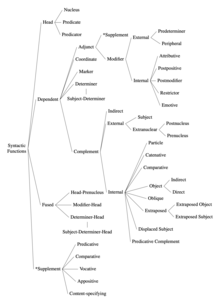
In linguistics, grammatical relations (also called grammatical functions, grammatical roles, or syntactic functions) are functional relationships between constituents in a clause. The standard examples of grammatical functions from traditional grammar are subject, direct object, and indirect object. In recent times, the syntactic functions (more generally referred to as grammatical relations), typified by the traditional categories of subject and object, have assumed an important role in linguistic theorizing, within a variety of approaches ranging from generative grammar to functional and cognitive theories.[1] Many modern theories of grammar are likely to acknowledge numerous further types of grammatical relations (e.g. complement, specifier, predicative, etc.).
The role of grammatical relations in theories of grammar is greatest in dependency grammars, which tend to posit dozens of distinct grammatical relations. Every head-dependent dependency bears a grammatical function.
Grammatical categories are assigned to the words and phrases that have the relations. This includes traditional parts of speech like nouns, verbs, adjectives, etc., and features like number and tense.
- ^ Butler, Christopher, S. (2012). "Syntactic functions in Functional Discourse Grammar and Role and Reference Grammar: an evaluative comparison". Language Sciences. 34 (4). Elsevier: 480–490. doi:10.1016/j.langsci.2012.03.002.
{{cite journal}}: CS1 maint: multiple names: authors list (link)